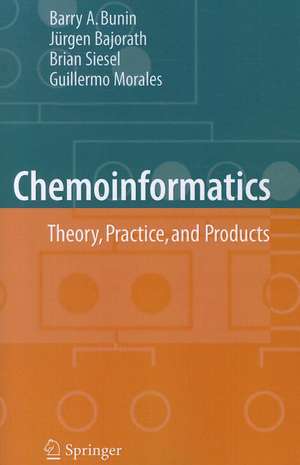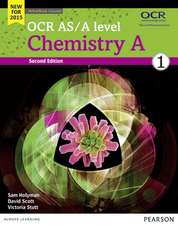Chemoinformatics: Theory, Practice, & Products
Autor Barry A. Bunin, Brian Siesel, Guillermo Morales, Jürgen Bajorathen Limba Engleză Paperback – 6 noi 2010
The book also provides a summary of currently available, state-of-the-art, commercial Chemoinformatics products, with a specific focus on databases, toolkits, and modelling technologies designed for drug discovery. It will be broadly useful as a reference text for experimentalists wishing to rapidly navigate the expanding field, as well asthe more expert computational scientists wishing to stay up to date.
| Toate formatele și edițiile | Preț | Express |
|---|---|---|
| Paperback (1) | 945.30 lei 6-8 săpt. | |
| SPRINGER NETHERLANDS – 6 noi 2010 | 945.30 lei 6-8 săpt. | |
| Hardback (1) | 953.35 lei 6-8 săpt. | |
| SPRINGER NETHERLANDS – 28 noi 2006 | 953.35 lei 6-8 săpt. |
Preț: 945.30 lei
Preț vechi: 1152.81 lei
-18% Nou
Puncte Express: 1418
Preț estimativ în valută:
180.89€ • 186.90$ • 150.48£
180.89€ • 186.90$ • 150.48£
Carte tipărită la comandă
Livrare economică 19 martie-02 aprilie
Preluare comenzi: 021 569.72.76
Specificații
ISBN-13: 9789048172504
ISBN-10: 9048172500
Pagini: 308
Ilustrații: XI, 295 p.
Dimensiuni: 160 x 240 x 16 mm
Greutate: 0.44 kg
Ediția:Softcover reprint of hardcover 1st ed. 2007
Editura: SPRINGER NETHERLANDS
Colecția Springer
Locul publicării:Dordrecht, Netherlands
ISBN-10: 9048172500
Pagini: 308
Ilustrații: XI, 295 p.
Dimensiuni: 160 x 240 x 16 mm
Greutate: 0.44 kg
Ediția:Softcover reprint of hardcover 1st ed. 2007
Editura: SPRINGER NETHERLANDS
Colecția Springer
Locul publicării:Dordrecht, Netherlands
Public țintă
ResearchCuprins
Theory section: Chemoinformatics theory. Chemoinformatics – what is it? Chemo- versus bio-informatics. Scientific origins. Fundamental concepts. Molecular descriptors and chemical spaces. Chemical spaces and molecular similarity.- Molecular similarity, dissimilarity, and diversity. Modification and simplification of chemical spaces. Compound classification and selection. Cluster analysis. Partitioning. Support vector machines. Similarity searching. Structural queries and graphs. Pharmacophores. Fingerprints. Machine learning methods. Genetic algorithms. Neural networks. Library design. Diverse libraries. Diversity estimation. Multi-objective design. Focused libraries. Quantitative structure-activity relationship analysis. Model building. Model evaluation. 3D-QSAR.- 4D-QSAR. Probabilistic methods. Virtual screening and compound filtering. Biologically active compounds. Virtual and high-throughput screening. Filter functions. From theory to practice. Database design. Compound selection for medicinal chemistry. Computational hit identification.- Practice and products sections: Accelrys. ACD Labs. Barnard Chemical Information Ltd. BioByte. CambridgeSoft. CAS/Scifinder. ChemAxon. Chemical Computing Group Inc. ChemInnovation Software, Inc. ChemNavigator. Chimera-Dock from UCSF. Collaborative Drug Discovery. Daylight. Eidogen-Sertanty (previously Libraria). Fujitsu Biosciences Group (previously Cache). Genego. GVK-Bio. Hypercube. IDBS. Infochem. Jubilant. Leadscope. MDL. Milano Chemometrics and QSAR Research Group. Molecular Discovery. Molecular Networks. Open Eye Scientific Software. Planaria-Software. PubChem. PyMol. RasMol and Protein Explore. Schrödinger, LLC. Scinova Technologies. Scitegic. Simulation Plus, Inc. Spotfire.-Summit PK. Symyx. TimTec. Tripos.
Recenzii
From the reviews:
"This book covers ‘the theory, commercially available packages and applications of Chemoinformatics’ … . It was designed to be a practical handbook for computational scientists, medicinal chemists, and biologists to help them find the right technology for their purpose." (Journal of the American Chemical Society, Vol. 129 (32), 2007)
"This book covers ‘the theory, commercially available packages and applications of Chemoinformatics’ … . It was designed to be a practical handbook for computational scientists, medicinal chemists, and biologists to help them find the right technology for their purpose." (Journal of the American Chemical Society, Vol. 129 (32), 2007)
Textul de pe ultima copertă
Chemoinformatics: Theory, Practice & Products covers theory, commercially available packages and applications of Chemoinformatics. Chemoinformatics is broadly defined as the use of information technology to assist in the acquisition, analysis and management of data and information relating to chemical compounds and their properties. This ranges from molecular modelling, to reactions, to spectra, to structure-activity relationships associated with chemicals. Computational scientists, chemists, and biologists all rely on the rapidly evolving field of Chemoinformatics. Chemoinformatics: Theory, Practice & Products is an essential handbook for determining the right Chemoinformatics method or technology to use. There has been an explosion of new Chemoinformatics tools and techniques. Each technique has its own utility, scope, and limitations, as well as meeting resistance to use by experimentalists. The purpose of Chemoinformatics: Theory, Practice & Products is to provide computational scientists, medicinal chemists and biologists with unique practical information and the underlying theories relating to modern Chemoinformatics and related drug discovery informatics technologies.
The book also provides a summary of currently available, state-of-the-art, commercial Chemoinformatics products, with a specific focus on databases, toolkits, and modelling technologies designed for drug discovery. It will be broadly useful as a reference text for experimentalists wishing to rapidly navigate the expanding field, as well as the more expert computational scientists wishing to stay up to date.
It is primarily intended for applied researchers from the chemical and pharmaceutical industry, academic investigators, and graduate students.
The book also provides a summary of currently available, state-of-the-art, commercial Chemoinformatics products, with a specific focus on databases, toolkits, and modelling technologies designed for drug discovery. It will be broadly useful as a reference text for experimentalists wishing to rapidly navigate the expanding field, as well as the more expert computational scientists wishing to stay up to date.
It is primarily intended for applied researchers from the chemical and pharmaceutical industry, academic investigators, and graduate students.
Caracteristici
Unique combination of theory and product overviews Colour Screenshots of major products from virtually all the major chemoinformatics suppliers Web-based orientation









